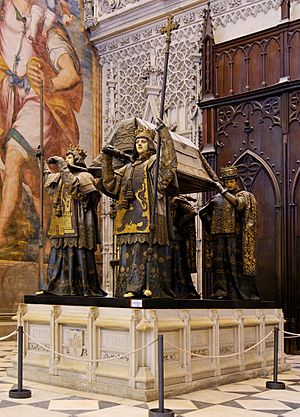Tomb of Christopher Columbus facts for kids

The Tomb of Christopher Columbus is a famous monument found in the Seville Cathedral in Spain. It has been there since 1899. But Christopher Columbus's remains, or what was left of his body, traveled a lot before ending up in Seville. They were in Valladolid, then in the Cartuja de Sevilla Monastery, then in Santo Domingo, and finally in Havana before coming to Seville.
Contents
The Journey of Columbus's Remains
First Stop: Valladolid
Christopher Columbus died on May 20, 1506, in the city of Valladolid, Spain. He was in Valladolid because he was following the King, Ferdinand the Catholic, who moved around a lot. We don't know the exact house where he died. It might have been a simple inn or the home of a sailor named Gil García.
His funeral took place at a church called Santa María La Antigua. After the funeral, his body was placed in the Convent of San Francisco in Valladolid.
Moving to Seville
A few years later, Columbus's son, Diego, wanted his father's remains moved. He chose the Monastery of Santa Maria de las Cuevas in Seville, also known as the Cartuja de Sevilla. Columbus himself was said to have liked this place.
On April 11, 1509, Columbus's cousin, Juan Antonio Colón, brought the remains to the monastery in Seville.
Across the Ocean to Santo Domingo
Later, it was decided that Columbus's remains should be moved to the Americas. A historian named Bartolomé de Las Casas wrote in 1561 that the body was taken from Seville to the main church in Santo Domingo. This happened sometime after 1536.
The main churches in America were very important. Only people approved by the king could be buried there. María de Toledo, who was Columbus's son Diego's wife, asked King Charles to move Columbus's remains. She was a powerful woman and lived in Santo Domingo.
The exact date of this move from Seville to Santo Domingo is not fully known. Some documents from King Charles V about burying Columbus in the Santo Domingo cathedral are from 1537, 1539, and 1540. Also, the Santo Domingo cathedral wasn't finished until 1540.
It's thought that María de Toledo might have carried the remains of both Christopher Columbus and her husband, Diego Colón, on a ship to Santo Domingo in 1544. Diego had also been buried in the Cartuja de Sevilla. Another idea is that Columbus's grandson, Luis Colón, took the remains to Santo Domingo in 1540.
Even though the exact date is unclear, it seems certain that Columbus's remains were moved to America. They stayed in the Cathedral of Santo Domingo until 1795.
The Transfer to Havana
In 1795, Spain gave part of the island of La Española (where Santo Domingo is) to France. Because of this change, Spain wanted to move Columbus's remains to a place that was still under Spanish control. That place was Havana, Cuba.
The archbishop of Santo Domingo, Fernando Portillo y Torres, thought moving Columbus's remains was very important. He worked with Spanish military leaders and political officials to make it happen.
The plan to dig up the remains was set for December 16, 1795. The official approval from the king came later, on March 5, 1796. The actual digging up of the remains happened on December 20, 1795. Everyone involved wrote down what happened, and official records were made.
Columbus's Remains Confirmed
In October 2024, scientists from the University of Granada in Spain made an important announcement. Led by forensic scientist José Antonio Lorente, they confirmed that the bones in the Seville Cathedral truly belong to Christopher Columbus. This confirmed what an earlier study from 2003 to 2005 had found.
They used DNA analysis to compare the bones in Seville with the remains of Columbus's son, Fernando, and his brother, Diego. The results showed a clear family connection.
Lorente also mentioned that some of Columbus's bones might still be in the Dominican Republic. However, officials there have not allowed the remains in Santo Domingo to be dug up for comparison.
See also
 In Spanish: Tumba de Cristóbal Colón para niños
In Spanish: Tumba de Cristóbal Colón para niños


